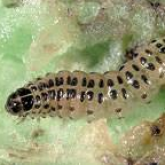Bean podborer

Bean podborer adult
© J. Wessels, Queensland Government

Bean podborer larvae
© J. Wessels, Queensland Government
A major pest of some pulse crops, bean podborer larvae feed on buds and flowers, and bore into the pod to eat developing seeds. Flowers and pods are bound together by a frass-covered web produced by the larva.
Scientific name
Other names
- Previously known as Maruca testulalis. Also known in some countries as the mung moth.
Description
Adults:
- slender body
- 20–25mm wingspan
- forewings are brown with a white band extending two-thirds down the wing from the leading edge
- hindwings are translucent white with an irregular brown border
- characteristic pose with outspread wings and raised body front.
Larvae:
- pale cream
- 2 rows of distinctive, paired, black markings on their back
- can reach 18mm long.
Eggs are translucent and flattened.
May be confused with
Moths may be confused with beet webworm moths but are slightly larger and have predominantly pale hindwings (hindwings of beet webworm are predominantly brown).
Distribution and habitat
Found in all parts of Australia but are more abundant in tropical and subtropical coastal regions.
Hosts
Adzuki bean, mungbean, cowpea, pigeon pea, navy bean. Sesbania is a favoured weed host.
Rarely damages:
- soybean because flowering does not overlap with podding
- peanuts because pods are underground.
Damage
Seeds within damaged pods are totally or partially eaten by larvae. Entry holes let in water, which stains remaining undamaged seeds.
In peanuts, unlike other legumes, larvae may web young leaves together and tunnel in plant stems.
Life cycle
Bean podborer moths are active at night but shelter within the plant canopy during the day.
Crops may be infested from early budding onwards:
- Eggs are laid on or in the flowers.
- Larval development takes 10–15 days from egg hatch
- young larvae feed inside flowers for 5–7 days
- medium larvae move into the pods, usually where flowers and pods are touching
- large larvae exit pods and pupate in the soil.
Monitoring and thresholds
Use a long handle sweep net to flush out distinctive moths.
Open all flowers from as many racemes (flower clusters) as possible to look for larvae (at least 10 racemes randomly sampled across a crop). Look for:
- webbing of flowers
- larvae in flowers
- well-defined entry hole in pods ringed with moist larval frass.
Note that beat sheet sampling will only dislodge a small proportion of larvae.
Natural enemies
Avoiding broad-spectrum pesticides prior to flowering may help conserve natural enemies, but beneficial insects are unlikely to control high populations.
Control
Eradicate the weed host Sesbania spp. from cropping areas.
Applying pesticides before larvae enter pods is the most effective. However, as larvae can feed entirely inside flowers for 4–5 days before attacking pods, they often encounter only degraded spray deposits.
Further information
- Bean podborer on the move in mungbeans—The Beatsheet
- Registered chemicals database—Australian Pesticides and Veterinary Medicines Authority (APVMA)